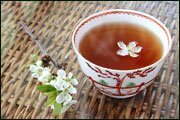Jasmine Tea

Jasmine Tea originates from the Song Dynasty (960-1279) and is made from green, oolong or pouchong tea base. The jasmine flower blooms at night and is rich in aroma at that time. The tea leaves are spread out and the jasmine is laid on top giving Jasmine Tea the rich aromatic properties that we have come to love.
Besides the pleasant aroma's, Jasmine Tea is believed to contain properties beneficial to our health. Jasmine is used in aromatherapy because of the sedating and relaxing properties, therefore making Jasmine Tea a popular choice to sip just before bed for those who are suffering from sleep deprivation. Another beneficial property may be the calming effects which are believed to help settle an upset stomach which is derived from the oolong base. Additionally, Jasmine Tea is believed to have anticancer benefits as well as antioxidants. It is also notable that Jasmine Tea has been found to lower the drinkers heart rate in controlled studies. While it is okay to drink Jasmine Tea daily, it may be more beneficial to drink it perhaps 3-5 times per week, and alternate the other days with other herbal teas that contain a different set of health benefits.
The quality of the Jasmine Tea largely depends on the quality of the green tea leaves used as a base. The aroma and jasmine properties depend on the aromatic process used. Jasmine Tea has a slightly sweet flavor and a rich floral scent. It is believed by the Chinese that herbal teas help to reduce weight gain, though there hasn't been sufficient evidence to date to substantiate these claims.
Jasmine Tea is widely served in Chinese Restaurants before serving dinner. Jasmine Tea can be found in specialty tea shops as well as larger retail chains. Sometimes, the Jasmine leaves are left in the tea, however this is purely for looks as the jasmine's scents are usually expired after the scenting process.
Most people prefer to use Jasmine Tea balls to prepare their tea. Boiling and draining the loose-leaf may be more beneficial since you will be using whole tea leaves and will avoid getting any clippings or stems. This process is a bit more time consuming and less convenient. Green and oolong teas should be steamed or lightly boiled at between 150F and 190F Green and oolong tea contains less caffeine than black tea, however, you can wash your tea leaves to even further decrease the amount of caffeine. To do this, simply steep your tea leaves for 2-3 minutes, discard the liquid, then steep again. The second batch will be significantly lower in caffeine content.
Whether you are drinking Jasmine Tea for it's health benefits or because you simply love the rich, slightly sweet and pungently aromatic properties you will find this exotic tea blend most enjoyable. From the calming effects to the anticancer properties, Jasmine Tea has something that almost everyone can benefit from. The popularity has contributed to the ease of purchasing Jasmine Tea, making it accessible everywhere. Jasmine Tea has been enjoyed around the world for many years and I assume it will be savored for many more.
Disclaimer: The information contained on this site is not intended to replace the diagnosis, treatment, consultation and services of a qualified Medical Practitioner. All information presented is in summary form and intended only for informational purposes. Always seek immediate medical attention for any illness you may have and never disregard the advice from qualified Medical Practitioners as something you have read on this site (or related sites) could be misinterpreted.

